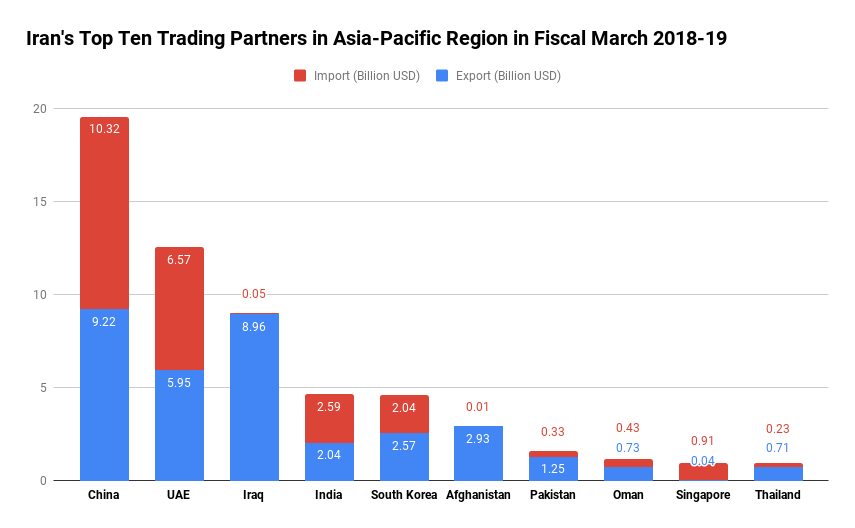Latest data released by the Islamic Republic of Iran Customs Administration show Iran’s exports totaled 103.7 million tons worth $37.67 billion during the year, indicating a 6.01% and 1.7% decline in tonnage and value respectively year-on-year.
Imports stood at 14.94 million tons worth $25.03 billion, down 26.53% and 25.4% in tonnage and value respectively YOY.
Iran recorded $12.64 billion in non-oil trade surplus with the Asia-Pacific region during the period, according to Financial Tribune.
The United Nations Regional Groups are geopolitical regional groups of UN member states. These are divided into five regional groups: the African Group, with 54 member states, the Asia-Pacific Group, with 53 member states, the Eastern European Group, with 23 member states, the Latin American and Caribbean Group, with 33 member states, the Western European and Others Group, with 28 member states, plus 1 member state (the United States) as an observer state.
The Asia-Pacific Group (formerly the Asian Group) has 53 members (27.5% of all UN members) and is the second largest regional group in terms of member states (one fewer than the African Group). Its territory comprises much of the continents of Asia and Oceania.
Turkey participates fully in both WEOG and Asia-Pacific Group, but for electoral purposes is considered a member of WEOG only. Therefore, it is not included among countries under review.
Main Commodities, Trading Partners
Iran mainly exported gas condensates, liquefied natural gas, liquefied propane, low-density oils, methanol and polyethylene grade film to the member states of Asia-Pacific Group.
In exchange, major commodities imported into Iran from the member states included semi- and wholly-milled rice, auto parts, graphite electrodes used in furnaces, field corn and cellphones.
In terms of trade value, China topped the list in the Asia-Pacific Group with bilateral trade with Iran standing at 35.6 million tons worth $19.53 billion, down by 10.86% and 12.21% in tonnage and value respectively YOY.
Exports to China amounted to 32.16 million tons worth $9.21 billion, registering an 8.43% decline in tonnage and 2.28% growth in value YOY.
China was Iran’s top export destination among the countries under review as well as in the whole world during the year.

In return, China exported 3.43 million tons of commodities worth $10.31 billion to Iran, down by 28.56% and 22.07% in tonnage and value respectively YOY.
China was the top exporter of goods to Iran among the member states of Asian-Pacific Group and also in the world.
Major Iranian commodities exported to China were liquefied propane, film grade polyethylene and methanol.
China mainly exported auto parts, graphite electrodes used in furnaces, machinery and LCD/LED screen modules to Iran.
The UAE was Iran’s second biggest trading partner in the region during the 12 months, as two-way commercial exchanges stood at 17.57 million tons worth $12.52 billion to register a 30.07% and 25.6% decline in tonnage and value respectively YOY.
Iran exported 13.75 million tons of goods worth $5.95 billion to the UAE, down by 24.53% and 12.06% in tonnage and value respectively YOY.
The UAE was Iran’s third export destination among nations under review and ranked third in the world during the period.
Iran’s exports to the UAE included gas condensates, low-density oils and mineral oils.
Iran imported 3.82 million tons of commodities worth $6.56 billion from the UAE, down 44.68% and 34.71% in tonnage and value respectively YOY, a majority of which were steam turbine parts, cellphones, butter and turbojet parts.
The UAE was the second exporter of goods to Iran among the nations under review as well as in the world.
Iraq was Iran’s third major trading partner in the Asia-Pacific region.
Mutual trade between Iran and Iraq amounted to 19.84 million tons worth $9.01 billion, indicating a 48.25% and 35.75% increase in tonnage and value respectively YOY.
Iran exported 19.76 million tons worth $8.96 billion to Iraq, up 49.15% and 36.71% in tonnage and value respectively YOY, while Iraqi exports to Iran reached 73,563 tons worth $58.69 million, down by 43.14% and 34.61% in tonnage and value respectively YOY.
Iraq was Iran’s second export destination as well as the 15th exporter of goods to Iran in the region. The country was Iran’s second export destination and 41st exporter to Iran in the world.
Liquefied natural gas, mineral oils, household cleaning detergents, low-density oils and tomatoes were Iran’s main goods exported to Iraq, while Iraq mainly exported low-density oil, machinery, aluminum alloy and cans.
India was the third major exporter of goods to Iran, after China and the UAE, in the Asia-Pacific region and fourth in the world. This is while Iran imported 2.01 million tons worth $2.59 billion from India during the period, up by 12.04% and 14.91% in tonnage and value respectively YOY.
Iran mainly imported semi- and wholly-milled rice, tea, graphite electrodes used in furnaces and oilcake from India.
Highest Growths, Declines in Trade
Trade with Nepal ($12.77 million), Maldives ($157,609) and Cambodia ($42,497) saw the highest YOY growths of 3,114.84%, 239.93% and 147.52% respectively, while trade with Yemen ($1 million), Saudi Arabia ($360,397) and Tajikistan ($104.41 million) witnessed the lowest declines of 88.07%, 83.66% and 54.82%.
Iran’s exports to Nepal ($12.77 million), Maldives ($157,609) and Cambodia ($42,497) saw the highest growths of 3,114.84%, 239.93% and 147.52% respectively, while exports to Yemen ($1 million), Saudi Arabia ($109,063) and the Philippines ($20.85 million) witnessed the biggest declines of 88.08%, 86.53% and 65.97% respectively.
Imports from Oman ($432.82 million), Kyrgyzstan ($11.37 million) and Tajikistan ($26.1 million) saw the highest growths of 99.75%, 87.83% and 87.48% respectively while imports from Bahrain ($853,991), Saudi Arabia ($251,334) and Lebanon ($12.56 million) witnessed the highest declines of 84.56%, 82% and 67.25% respectively.


